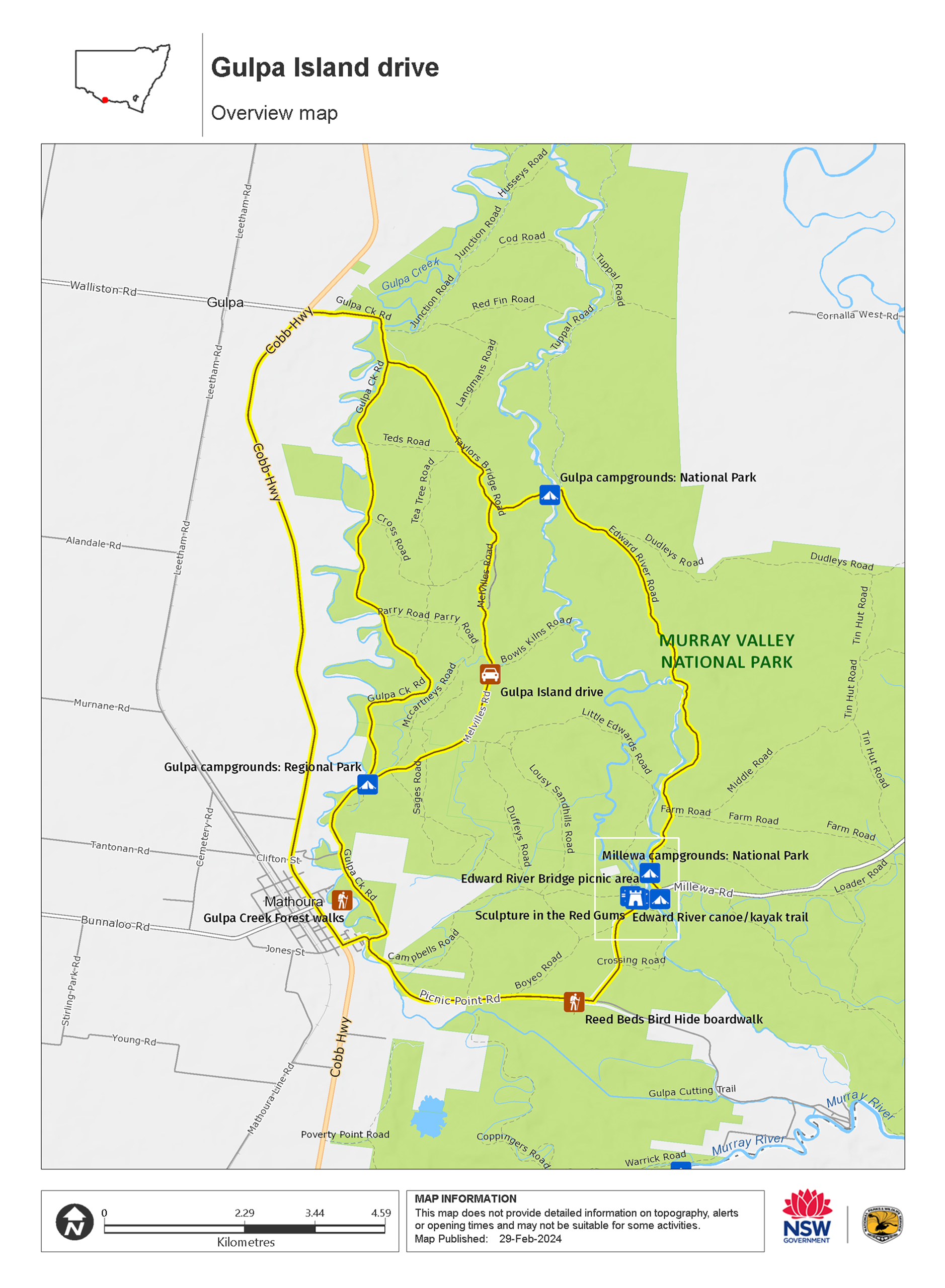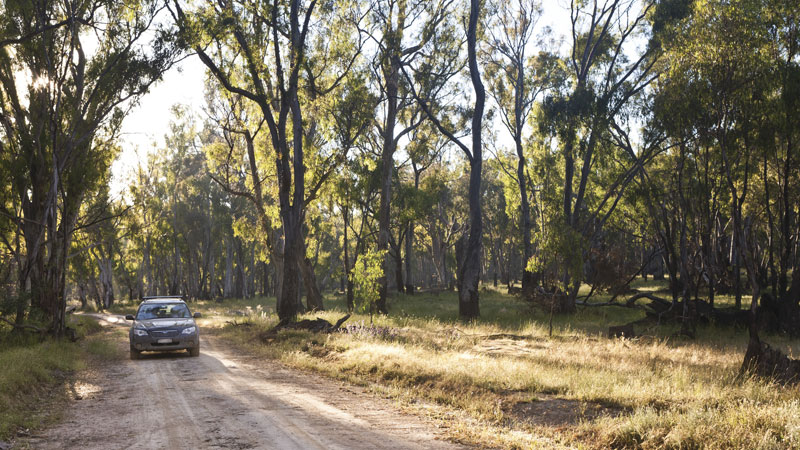Overview
Gulpa Island drive takes you through the towering river red gums of Murray Valley National Park and Regional Park. There are plenty of scenic views to enjoy along this drive and plenty of places to stop for a walk to stretch your legs.
- Accessibility
- Hard
- Distance
- 100km
- Grade
- Easy
- Please note
- Remember to take your binoculars and camera to capture the wonderful birds of the wetlands – a bird identification book might also be handy
- Please make sure you exercise caution when swimming in rivers as there may be strong currents. Do not dive into the river as there can be submerged logs and the water may be shallow.
- Check the weather before you set out as roads within Murray Valley National Park may be closed during wet weather
- This park is in a remote location, please ensure you are thoroughly prepared, bring appropriate clothing and equipment and advise a family member or friend of your travel plans.
This scenic drive takes you through the towering river red gums of the northern part of Murray Valley National Park and Regional Park. There are places to stop along the way to stretch your legs, try the Gulpa Creek Forest walks or you could even paddle your kayak along sections of the river.
When you’re feeling hungry, stop for a picnic lunch at one of the many tranquil and scenic spots along the drive such as Edward River Bridge picnic area. Time moves slowly in this special place; take as long as you like to explore it or stay overnight at Edward River Bridge campground.
Remember to bring your binoculars, this part of the park is great for birdwatching or head to Reed Beds Bird Hide boardwalk for the best opportunities to see migratory birds.
Map

Map

Map legend

Local alerts
For the latest updates on fires, closures and other alerts in this area, see https://www.nationalparks.nsw.gov.au/things-to-do/driving-routes/gulpa-island-drive/local-alerts
General enquiries
- National Parks Contact Centre
- 7am to 7pm daily
- 1300 072 757 (13000 PARKS) for the cost of a local call within Australia excluding mobiles
- parks.info@environment.nsw.gov.au
Park info
- in Murray Valley National Park in the Murray-Riverina region
Murray Valley National Park is always open but may have to close at times due to poor weather or fire danger.
- in Murray Valley Regional Park in the Murray-Riverina region
Visitor info
All the practical information you need to know about Gulpa Island drive.
Getting there and parking
Get driving directions
Gulpa Island drive is in the Gulpa Island precinct of Murray Valley National Park. To get there:
- From Mathoura, cross Poley’s Bridge and continue on Millewa Road.
- After about 5km, turn left onto Tocumwal Road.
- Turn left just past Edwards Bridge and continue along the drive
Parking
Parking is available at various sites along the drive.
Best times to visit
There are lots of great things waiting for you in Murray Valley National Park. Here are some of the highlights.
Autumn
The perfect time for a camping holiday: the days are cooler and the nights are not yet too chilly.
Spring
If it's been a wet winter white ibis and straw necked ibis will be nesting from late winter through to spring.
Summer
A great time for water activities on the Murray - swimming in the river is a delightful way to spend your time.
Winter
Winter is the time when the river red gum forests are flooded with water and many locations can be inaccessible. Check local alerts for closed areas if you’re planning a winter drive.
Weather, temperature and rainfall
Summer temperature
Average
12°C and 32°C
Highest recorded
44.7°C
Winter temperature
Average
3°C and 17°C
Lowest recorded
–3.8°C
Rainfall
Wettest month
August to October
Driest month
February
The area’s highest recorded rainfall in one day
98mm
Maps and downloads
Accessibility
Disability access level - hard
- Wheelchairs can access this area with some difficulty
Prohibited
Camp fires and solid fuel burners
There are solid fuel fire bans in place for the entire summer season, generally from 1 October until Easter.
Pets
Pets and domestic animals (other than certified assistance animals) are not permitted. Find out which regional parks allow dog walking and see the pets in parks policy for more information.
Dogs are not permitted in Murray Valley National Park however they may be brought into Murray Valley Regional Park, as long as park restrictions surrounding dogs are observed.
If you're travelling through a national park or reserve on a public road you can have pets inside your vehicle. However, you must keep them inside your vehicle while driving through national parks or reserves. You must also comply with any conditions in the park’s plan of management, and you cannot stop to visit the park or use park facilities (unless for safety reasons, or to use publicly accessible toilets).
Smoking
NSW national parks are no smoking areas.
Learn more
Gulpa Island drive is in Murray Valley National Park. Here are just some of the reasons why this park is special:
Aboriginal heritage

The river red gum forests of the Murray Valley are the traditional Country for Aboriginal people. The landscape and all that it contains; rivers, forests, birds and animals are part of cultural beliefs and feature in Dreaming stories. The park provided a wealth of resources, including plants that were used as medicines and in tool making. The river was a rich food source; in some seasons the water was so clear and the fish plentiful. When you're exploring the park, keep your eyes open for Aboriginal sites, especially middens, oven mounds and scarred trees, where bark has been removed from the tree to make canoes, coolamons and shields.
An abundance of treasures

The Ramsar-listed Murray Valley wetland is home to over 60 threatened native animal species and 40 threatened plant species. Lay down the paddle of your canoe and sit in the silence, enjoying the company of egrets and cormorants, and keep an eye out for the superb parrot, slender and bright green. You may also see night herons, black swans, yellow rosellas, ducks, falcons, cockatoos, tree creepers, pardalotes, kingfishers and owls - this is truly a bird-lover's paradise.
- Moira Drive The scenic Moira drive takes you through the gorgeous river red gum forest around the mighty Murray River. Walk to the water bird observatory and stop for a picnic lunch.
- Murray River canoe trails These 4 canoe trails in Murray Valley National Park and Victoria’s Barmah National Park offer something for every paddler. Canoe the flowing Murray River, secluded creeks or Barmah Lake.
- Personalised birding tours around Deniliquin Keen birders will love these tailored outings by Australian Ornithological Services. They're a great way see rare and endemic birds, including plains wanderers, in the unique ecosystems near the outback town of Deniliquin.
- Reed Beds Bird Hide boardwalk It’s an easy walk along the boardwalk to Reed Beds Bird Hide, with fun things to do along the way. Listen to see how many different bird calls you can hear on the way.
River red gum country

This iconic landscape features the huge river red gums soaring from the banks of the Murray and wetlands that make up this part of the Riverina's important ecosystem. This new park, formed from a number of former state forests, is part of the largest continuous river red gum forest in the southern hemisphere and is an important and unique ecosystem.
- Moira Drive The scenic Moira drive takes you through the gorgeous river red gum forest around the mighty Murray River. Walk to the water bird observatory and stop for a picnic lunch.
- Personalised birding tours around Deniliquin Keen birders will love these tailored outings by Australian Ornithological Services. They're a great way see rare and endemic birds, including plains wanderers, in the unique ecosystems near the outback town of Deniliquin.
The paddle steamer era

The paddle steamer era ran from the 1860s to the early 1900s and was important for transporting people and supplies along the Murray River. Trees along river were marked with large numbers cut into the bark, spaced 1-mile (1.6km) apart from Albury to Wentworth. The numbers represented the distance in miles from Albury and were made during a government survey of the Murray River from 1868 to 1872. Some of these markings can still be seen today.
Plants and animals protected in this park
Animals
-

Australian pelican (Pelecanus conspicillatus)
The curious pelican is Australia’s largest flying bird and has the longest bill of any bird in the world. These Australian birds are found throughout Australian waterways and the pelican uses its throat pouch to trawl for fish. Pelicans breed all year round, congregating in large colonies on secluded beaches and islands.
-

Eastern snake-necked turtle (Chelodina longicollis)
Found across most of NSW, the eastern snake-necked turtle, also known as the eastern long-necked turtle, can be found in swamps, lakes and inland waterways. This freshwater turtle is carnivorous and lives most of its life submerged on the water’s edge, searching for worms and snails.
-

Kookaburra (Dacelo novaeguineae)
Of the 2 species of kookaburra found in Australia, the laughing kookaburra is the best-known and the largest of the native kingfishers. With its distinctive riotous call, the laughing kookaburra is commonly heard in open woodlands and forests throughout NSW national parks, making these ideal spots for bird watching.
-

Common brushtail possum (Trichosurus vulpecula)
One of the most widespread of Australian tree-dwelling marsupials, the common brushtail possum is found across most of NSW in woodlands, rainforests and urban areas. With strong claws, a prehensile tail and opposable digits, these native Australian animals are well-adapted for life amongst the trees.
Plants
-

River red gum (Eucalpytus camaldulensis)
Australian native plants, majestic river red gum trees are widespread across Australian inland river systems. The river red gum is a dominant tree species of the Murray-Darling basin which spans NSW, Queensland and Victoria. This iconic native eucalypt grows to a height of 30m and is thought to have a lifespan up to 500-1000 years.

